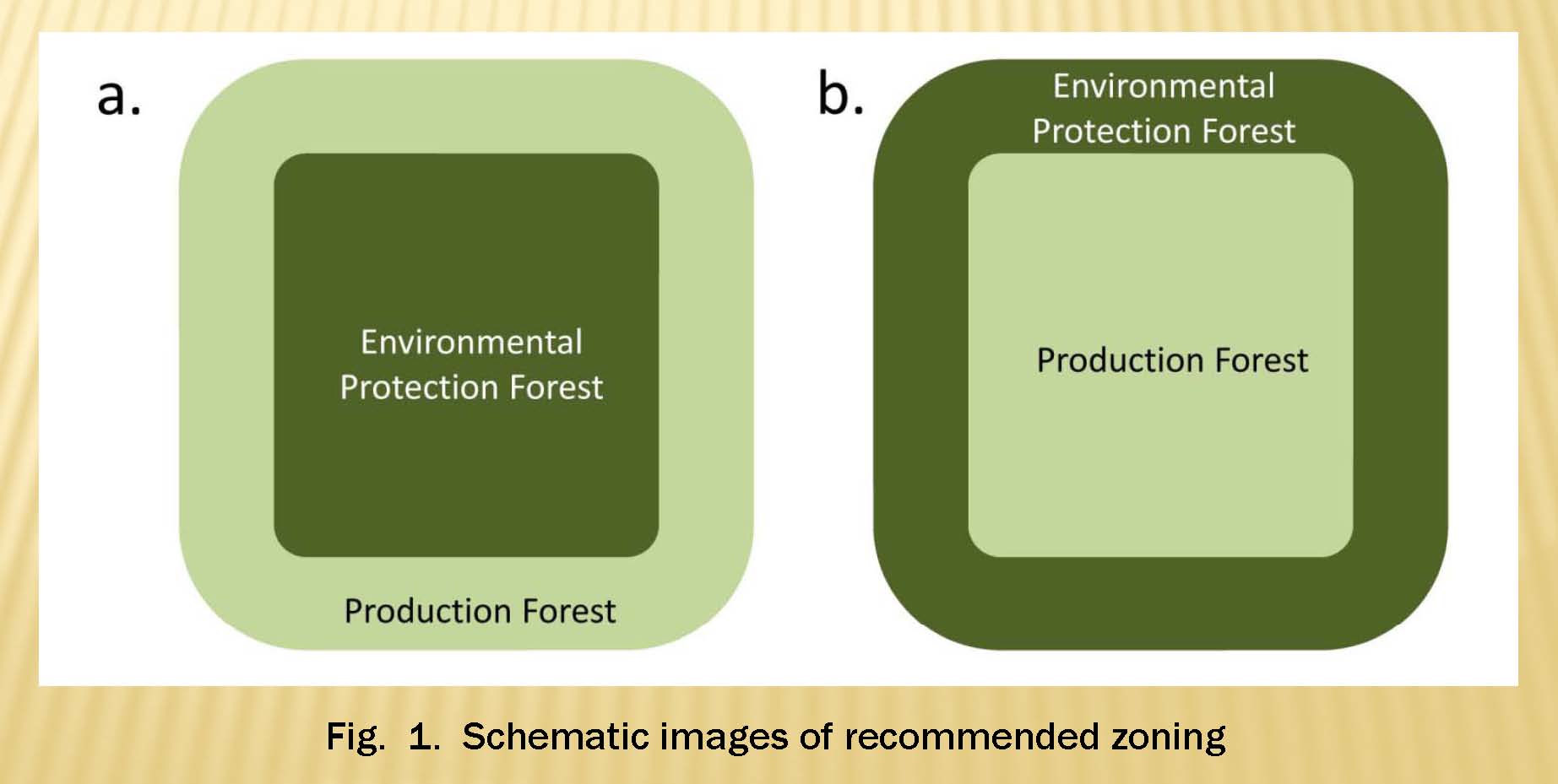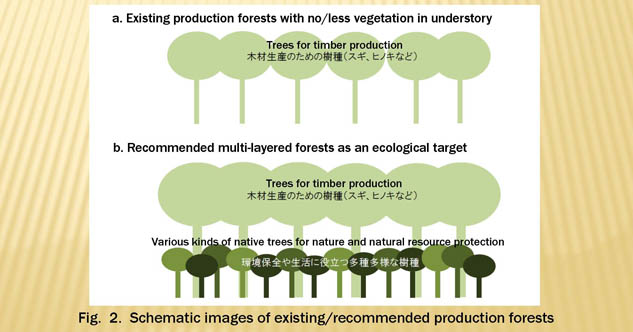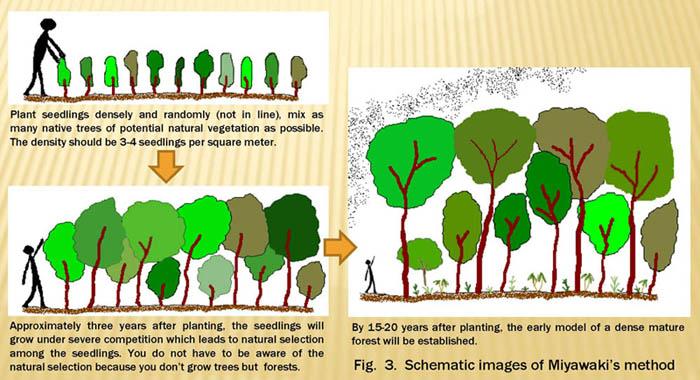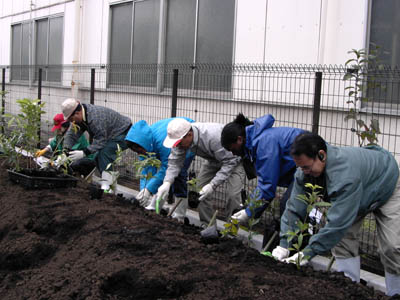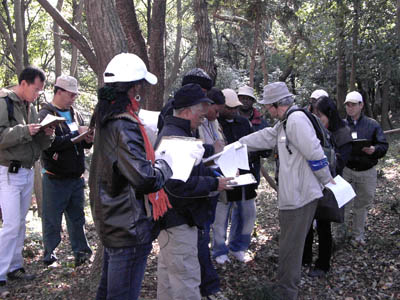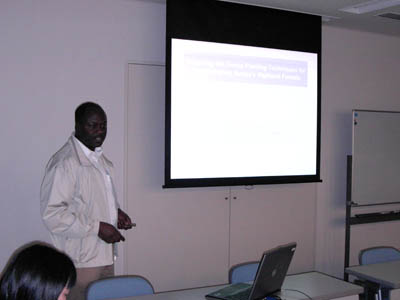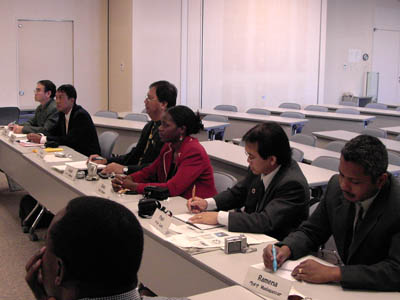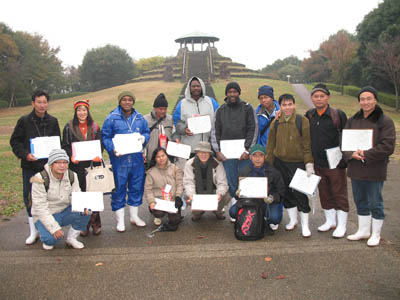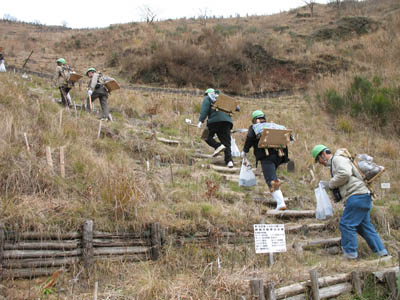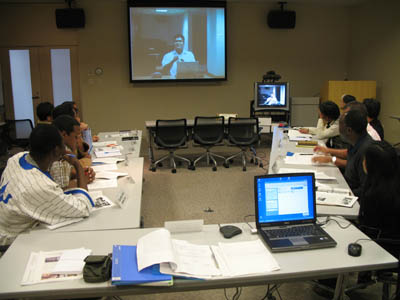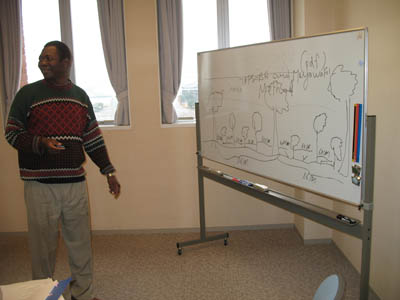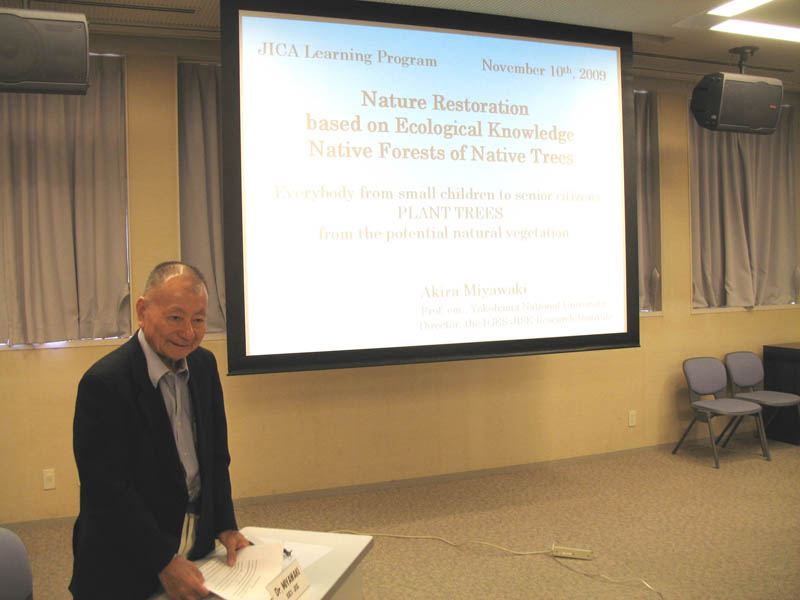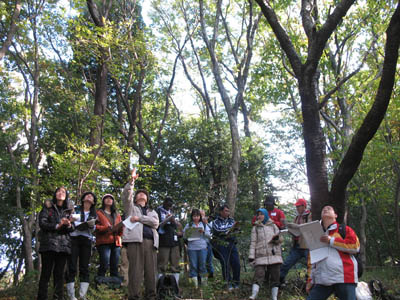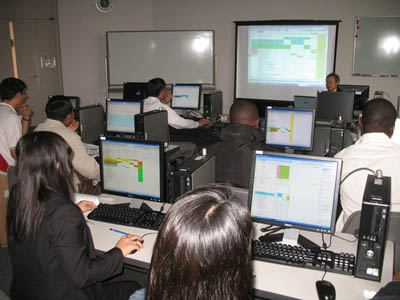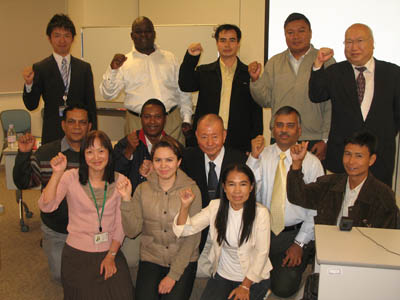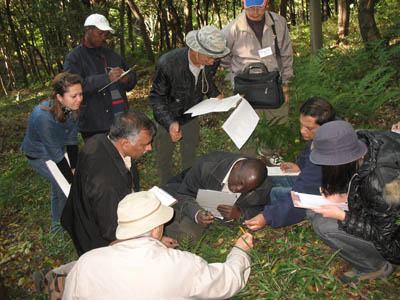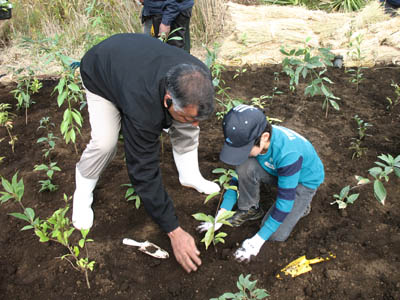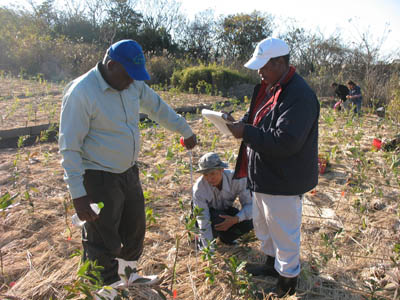|
|
 BACKGROUND & OVERALL CONCEPT
 This is one of the issues that affects Asia and Africa because many anthropogenic factors cause serious phenomena such as deforestation, soil erosion etc. For the resolution to this issue, it is important to: 1) formulate and implement an appropriate action plan for sustainable management of lands and natural resources, 2) promote the knowledge and techniques of land rehabilitation to those who use lands such as farmers, local communities, etc. This issue does not only affect the local community but also extends globally because the rehabilitation of degraded lands contributes to the prevention against natural disasters, poverty among local villagers and also the global warming. This is one of the issues that affects Asia and Africa because many anthropogenic factors cause serious phenomena such as deforestation, soil erosion etc. For the resolution to this issue, it is important to: 1) formulate and implement an appropriate action plan for sustainable management of lands and natural resources, 2) promote the knowledge and techniques of land rehabilitation to those who use lands such as farmers, local communities, etc. This issue does not only affect the local community but also extends globally because the rehabilitation of degraded lands contributes to the prevention against natural disasters, poverty among local villagers and also the global warming.
 IGES-JISE is an implementing partner of JICA region focused training program entitled "Rehabilitation of Degraded Lands in Asia and Africa." This course program aims to encourage hands-on activities promoted by participants in JICA training programs by giving them technical support and advices so that their activities based on their draft action plans can be fruitful and sustainable and should be adaptive through self-reliance. What follows is a more detailed information regarding the training course. IGES-JISE is an implementing partner of JICA region focused training program entitled "Rehabilitation of Degraded Lands in Asia and Africa." This course program aims to encourage hands-on activities promoted by participants in JICA training programs by giving them technical support and advices so that their activities based on their draft action plans can be fruitful and sustainable and should be adaptive through self-reliance. What follows is a more detailed information regarding the training course.
Title: Rehabilitation of Degraded Lands in Asia and Africa
Organizer: JICA Yokohama
Implementing Partner: IGES-JISE
Course Leader: Dr. Tomoki YAGASAKI, Researcher, IGES-JISE
Period of the Program (JFY 2010): Oct 26, 2010 to Dec. 18, 2010
Venue: JICA Yokohama, Japan
Target Regions or Countries: Asian and African Countries
Eligible/Target Organization: Ministry of Agriculture and Forestry, Universities etc.
Total Number of Participants: 12 participants
Language: English
|
|
 PROGRAM OBJECTIVES
 At the end of the program, the participants are expected to achieve the following; At the end of the program, the participants are expected to achieve the following;
 1) to deepen the participant's understanding and knowledge on land degradation in Asia and Africa, 1) to deepen the participant's understanding and knowledge on land degradation in Asia and Africa,
 2) to improve their skills of land rehabilitation, 2) to improve their skills of land rehabilitation,
 3) to make draft action plans that identify their major responsibility and schemes for the projects. 3) to make draft action plans that identify their major responsibility and schemes for the projects.
|
 OVERALL GOAL
 This training program is expected to achieve the following overall goal; This training program is expected to achieve the following overall goal;
 1) to train skilled personnel, 1) to train skilled personnel,
 2) to disseminate the rehabilitation techniques to local stakeholders, 2) to disseminate the rehabilitation techniques to local stakeholders,
 3) to promote hands-on activities toward land rehabilitation. 3) to promote hands-on activities toward land rehabilitation.
|
|
 RECIPIENT
 This proposal is intended to JICA and their participants of the training programs who are engaged in land rehabilitation planning and implementation at a local government level, especially in a community which belong to organizations such as Forestry Agency/Ministry of Agriculture and Forestry, Land Use Planning Agency, and Universities. This proposal is intended to JICA and their participants of the training programs who are engaged in land rehabilitation planning and implementation at a local government level, especially in a community which belong to organizations such as Forestry Agency/Ministry of Agriculture and Forestry, Land Use Planning Agency, and Universities.
|
 PLAN OF ACTION/EXPECTATION
 Participants shall have an opportunity to get knowledge and advice on vegetation ecology and its application to land rehabilitation through lectures, seminars, workshops, collaborative research and field work with Japanese experts on site. Participants are going to formulate their action plans taking into consideration that they must promote hands-on activities based on their knowledge and skill. Participants shall have an opportunity to get knowledge and advice on vegetation ecology and its application to land rehabilitation through lectures, seminars, workshops, collaborative research and field work with Japanese experts on site. Participants are going to formulate their action plans taking into consideration that they must promote hands-on activities based on their knowledge and skill.
|
 COURSE SCHEDULE (JFY 2010)
 1st Stage (Nov 1-Nov 3, 2010) 1st Stage (Nov 1-Nov 3, 2010)
 1) Program Orientation 1) Program Orientation
 2) Lecture on the Nature Restoration based on Ecological Knowledge, Native Forests of Native Trees 2) Lecture on the Nature Restoration based on Ecological Knowledge, Native Forests of Native Trees
 3) Presentation of Job Reports 3) Presentation of Job Reports
 2nd Stage (Nov 4-Nov 26, 2010) 2nd Stage (Nov 4-Nov 26, 2010)
 1) Observation of the Environmental Protection Forests 1) Observation of the Environmental Protection Forests
 2) Lectures and Exercises on Vegetation Ecology and its Application to Land Rehabilitation 2) Lectures and Exercises on Vegetation Ecology and its Application to Land Rehabilitation
 3) Reforestation Training based on Vegetation Ecological Technique (Miyawaki Method) 3) Reforestation Training based on Vegetation Ecological Technique (Miyawaki Method)
 4) Working Evaluation 4) Working Evaluation
 3rd Stage (Nov 27-Dec 9, 2010) 3rd Stage (Nov 27-Dec 9, 2010)
 1) Observation of the Rehabilitation Sites in Japan 1) Observation of the Rehabilitation Sites in Japan
 2) Seminar -The Issues and Perspective on Land Rehabilitation in Asia and Africa 2) Seminar -The Issues and Perspective on Land Rehabilitation in Asia and Africa
 3) Lectures and Exercises on Charcoal Making and its Application 3) Lectures and Exercises on Charcoal Making and its Application
 4) Discussions & Exchanges Information between Current & Former Participants 4) Discussions & Exchanges Information between Current & Former Participants
 5) Workshop toward Starting Hands-on Activities for Land Rehabilitation 5) Workshop toward Starting Hands-on Activities for Land Rehabilitation
 4th Stage (Dec 10-Dec 16, 2010) 4th Stage (Dec 10-Dec 16, 2010)
 1) Room Exercise of Making Draft Action Plan 1) Room Exercise of Making Draft Action Plan
 2) Presentation of Draft Action Plan 2) Presentation of Draft Action Plan
|
|
 PHYTOSOCIOLOGICAL SURVEY
 Vegetation ecological survey based on phytosociology (Braun-Blanquet, 1964) will be conducted by Japanese experts and some of the local stakeholders for identification of useful applicable native vegetation to the environmental protection and estimation of potential natural vegetation (Tuxen, 1956). Vegetation ecological survey based on phytosociology (Braun-Blanquet, 1964) will be conducted by Japanese experts and some of the local stakeholders for identification of useful applicable native vegetation to the environmental protection and estimation of potential natural vegetation (Tuxen, 1956).
|
 ETHNOBIOLOGICAL SURVEY
 The ethnobiological survey will be conducted by Japanese experts and the local stakeholders for finding applicable native species to land rehabilitation that will best match the ecological requirements and social needs. This will contribute to making win-win proposals between environmental protection and natural resource management among local stakeholders under long-term planning. The ethnobiological survey will be conducted by Japanese experts and the local stakeholders for finding applicable native species to land rehabilitation that will best match the ecological requirements and social needs. This will contribute to making win-win proposals between environmental protection and natural resource management among local stakeholders under long-term planning.
|
 TREE PLANTING EXERCISE
 The tree planting exercise will be implemented by Japanese experts and the local stakeholders to deepen the participant's understanding of the specific unique planting technique in Japan. The tree planting exercise will be implemented by Japanese experts and the local stakeholders to deepen the participant's understanding of the specific unique planting technique in Japan.
|
|
 IDENTIFICATION OF USEFUL APPLICABLE NATIVE TREES
 Some native species will be focused on because they are thought to be one of the useful native species of potential natural vegetation there. However, it may be prohibited for the local villagers to cut/use it, because it grows inside the protected areas. This program focuses on the possibility of applying native trees for fuelwood/charcoal to creating the multi-layered forests as an ecological target. Some native species will be focused on because they are thought to be one of the useful native species of potential natural vegetation there. However, it may be prohibited for the local villagers to cut/use it, because it grows inside the protected areas. This program focuses on the possibility of applying native trees for fuelwood/charcoal to creating the multi-layered forests as an ecological target.
|
 INVENTORY OF APPLICABLE NATIVE SPECIES
 According to the two methods mentioned previously, useful applicable native vegetation/species will be identified and listed as draft inventory for nurseries. Feasibility study on the implementation of the preparation for experimental rehabilitation sites and seedlings will be conducted. According to the two methods mentioned previously, useful applicable native vegetation/species will be identified and listed as draft inventory for nurseries. Feasibility study on the implementation of the preparation for experimental rehabilitation sites and seedlings will be conducted.
|
|
 WISE ZONING
 This program focuses on wise zoning (see Fig. 1 below) that arranges production forests and environmental protection forests according to the landfs ecological characteristics (e.g. slope, topography, etc.). The schematic images of recommended zoning (Fig. 1) are as follows: This program focuses on wise zoning (see Fig. 1 below) that arranges production forests and environmental protection forests according to the landfs ecological characteristics (e.g. slope, topography, etc.). The schematic images of recommended zoning (Fig. 1) are as follows:
 a. Environmental protection forest along with production forest as a buffer a. Environmental protection forest along with production forest as a buffer
 b. Production forest along with environmental protection forest as a buffer b. Production forest along with environmental protection forest as a buffer
|
|
 MULTI-LAYERED FORESTS WITH MULTI-FUNCTIONS
 The production forests should be tolerant against natural disasters and human disturbance. The existing forest that has non or has less vegetation in understory will contribute to severe soil erosion (see Fig. 2-a below). This proposed program focuses on multi-layered forests with various kinds of native plant species as an ecological target (see Fig. 2-b below). The production forests should be tolerant against natural disasters and human disturbance. The existing forest that has non or has less vegetation in understory will contribute to severe soil erosion (see Fig. 2-a below). This proposed program focuses on multi-layered forests with various kinds of native plant species as an ecological target (see Fig. 2-b below).
|
|
 WHAT SHOULD WE DO TO SOLVE THESE ISSUES?
 The following issues are the clues to solution in considering what kind of trees/techniques we need to apply to the vegetation management. The topics that we should take into consideration are as follows: The following issues are the clues to solution in considering what kind of trees/techniques we need to apply to the vegetation management. The topics that we should take into consideration are as follows:
 1) What types of vegetation do we have in our respective countries? 1) What types of vegetation do we have in our respective countries?
 2) What benefits can we get from each type of vegetation? 2) What benefits can we get from each type of vegetation?
 3) What types of vegetation can grow on the lands? 3) What types of vegetation can grow on the lands?
 4) What types of vegetation do local people want? 4) What types of vegetation do local people want?
 5) What types of vegetation should we grow on the lands? 5) What types of vegetation should we grow on the lands?
 6) Where should we rehabilitate? 6) Where should we rehabilitate?
 7) How fast can we rehabilitate a degraded forest? 7) How fast can we rehabilitate a degraded forest?
|
 RECOMMENDED TECHNIQUE
 A specific unique technique in ecology-based reforestation (i.e. Miyawaki fs method) (Miyawaki et al., 1993) is going to be applied to this program towards early growth of dense mature forests. A specific unique technique in ecology-based reforestation (i.e. Miyawaki fs method) (Miyawaki et al., 1993) is going to be applied to this program towards early growth of dense mature forests.
|
|
 SUSTAINABLE/ADAPTIVE MANAGEMENT
 The scheme of the future experimental projects will be discussed and formulated with stakeholders taking into account not only the ecological aspects but also the socio-economic aspects. This program focuses on the possibility of creating technical options for forest/vegetation management in collaboration with local stakeholders. The scheme of the future experimental projects will be discussed and formulated with stakeholders taking into account not only the ecological aspects but also the socio-economic aspects. This program focuses on the possibility of creating technical options for forest/vegetation management in collaboration with local stakeholders.
|
|
 ACADEMIC PAPER
 Yagasaki, T. 2009. Issues and Prospects towards Rehabilitation of Degraded Lands in Asia and Africa -A Discussion Considering the Results of the Implementation of JICA Training Programs. Eco-Habitat 16 (1): 77-92.(in Japanese) Yagasaki, T. 2009. Issues and Prospects towards Rehabilitation of Degraded Lands in Asia and Africa -A Discussion Considering the Results of the Implementation of JICA Training Programs. Eco-Habitat 16 (1): 77-92.(in Japanese)
|
 PHOTO

|
Field Exercise on Tree Planting (JFY 2007)
|
Field Exercise on Vegetation Ecology (JFY 2007)
|
Presentation of Draft Action Plan (JFY 2007)
|
Active Participation in the Course (JFY 2007)
|
Field Exercise on Mapping Actual Vegetation (JFY 2008)
|
Field Exercise on Tree Planting (JFY 2008)
|
Video Conference with Former Participants (JFY 2008)
|
Presentation of Draft Action Plan (JFY 2008)
|
Lecture by Dr. Miyawaki (JFY 2009)
|
Field Exercise on Vegetation Ecology (JFY 2009)
|
Room Exercise on Vegetation Ecology (JFY 2009)
|
Active Participants in the Course (JFY 2009)
|
Team 2010 in JICA Yokohama (JFY 2010)
|
Field Exercise on Vegetation Ecology (JFY 2010)
|
Tree Planting Exercise based on Vegetation Ecology (JFY 2010)
|
Exercise on Ecological Monitoring of Tree Growth (JFY 2010)
|
|
 TO ALL STAKEHOLDERS
 First of all, I would like to express my gratitude to all the lecturers: Dr. Akira MIYAWAKI, Dr. Shigetoshi OKUDA, Dr. Kazue FUJIWARA, Dr. Kei-ichi ONO, Dr. Yukira MOCHIDA, Dr. Yuhide MURAKAMI, Dr. Shin-ichi SUZUKI, Dr. Shin-ichi MEGURO, Mr. Hisanori HAYASHI, Dr. Kimihiko HYAKUMURA, Dr. Henry SCHEYVENS, Dr. Yosei OIKAWA, Dr. Katsuhiro ONO, Mr. Yoshio TAKAHASHI, Mr. Takahumi IDENAWA, Mr. Yoshitake TAKANO, Dr. Naoto HOSHI, Ms. Ayako ISHIMURA, and Mr. Takuya FURUKAWA for their cooperation. I would also like to acknowledge all the staff who have labored for this program: Mr. Naoto FURUKAWA, Ms. Yoshie ONODERA, Ms. Ako MUTO, Ms. Hiromi SHINOZAKI, and Mr. Makoto NIKKAWA. Finally, my deepest gratitude to all the participants from Asia and Africa for their active participation in the training course. First of all, I would like to express my gratitude to all the lecturers: Dr. Akira MIYAWAKI, Dr. Shigetoshi OKUDA, Dr. Kazue FUJIWARA, Dr. Kei-ichi ONO, Dr. Yukira MOCHIDA, Dr. Yuhide MURAKAMI, Dr. Shin-ichi SUZUKI, Dr. Shin-ichi MEGURO, Mr. Hisanori HAYASHI, Dr. Kimihiko HYAKUMURA, Dr. Henry SCHEYVENS, Dr. Yosei OIKAWA, Dr. Katsuhiro ONO, Mr. Yoshio TAKAHASHI, Mr. Takahumi IDENAWA, Mr. Yoshitake TAKANO, Dr. Naoto HOSHI, Ms. Ayako ISHIMURA, and Mr. Takuya FURUKAWA for their cooperation. I would also like to acknowledge all the staff who have labored for this program: Mr. Naoto FURUKAWA, Ms. Yoshie ONODERA, Ms. Ako MUTO, Ms. Hiromi SHINOZAKI, and Mr. Makoto NIKKAWA. Finally, my deepest gratitude to all the participants from Asia and Africa for their active participation in the training course.
|

|








